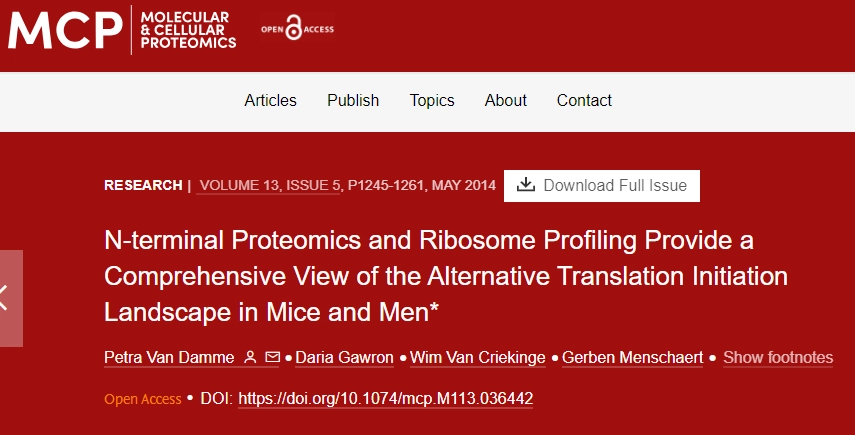Alternative proteoform discovery
26 March 2024
N-terminal Proteomics and Ribosome Profiling Provide a Comprehensive View of the Alternative Translation Initiation Landscape in Mice and Men

Van Damme P, Gawron D, Van Criekinge W, Menschaert G. N-terminal proteomics and ribosome profiling provide a comprehensive view of the alternative translation initiation landscape in mice and men. Mol Cell Proteomics. 2014 May;13(5):1245-61. doi: 10.1074/mcp.M113.036442. Epub 2014 Mar 12. PMID: 24623590; PMCID: PMC4014282.
Usage of presumed 5′UTR or downstream in-frame AUG codons, next to non-AUG codons as translation start codons contributes to the diversity of a proteome as protein isoforms harboring different N-terminal extensions or truncations can serve different functions. Recent ribosome profiling data revealed a highly underestimated occurrence of database nonannotated, and thus alternative translation initiation sites (aTIS), at the mRNA level. N-terminomics data in addition showed that in higher eukaryotes around 20% of all identified protein N termini point to such aTIS, to incorrect assignments of the translation start codon, translation initiation at near-cognate start codons, or to alternative splicing. We here report on more than 1700 unique alternative protein N termini identified at the proteome level in human and murine cellular proteomes. Customized databases, created using the translation initiation mapping obtained from ribosome profiling data, additionally demonstrate the use of initiator methionine decoded near-cognate start codons besides the existence of N-terminal extended protein variants at the level of the proteome. Various newly identified aTIS were confirmed by mutagenesis, and meta-analyses demonstrated that aTIS reside in strong Kozak-like motifs and are conserved among eukaryotes, hinting to a possible biological impact. Finally, TargetP analysis predicted that the usage of aTIS often results in altered subcellular localization patterns, providing a mechanism for functional diversification.
Keywords: Alternative translation initiation sites (aTIS), Non-AUG start codons, Protein isoform diversity

